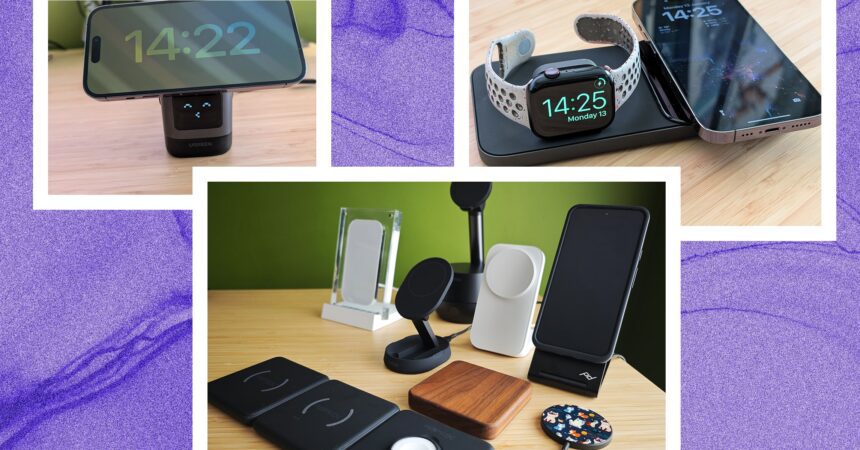It almost lives up to the hype. It’s not completely wireless—a cord connects from a wall outlet to the charging pad—and it won’t juice up your smartphone any quicker than using a traditional charging cable. Still, I feel a tinge of disappointment whenever I encounter a smartphone that doesn’t feature this capability. I’ve grown accustomed to simply placing my phone on a charging pad at night, and searching for a cable in the dark seems like a hassle. For me, it’s all about convenience.
After assessing over 100 products in recent years, my colleague Simon Hill and I have distinguished the better wireless chargers from the inferior ones (and there are certainly some poor options out there). There is an abundance of styles, shapes, and materials available, offering various choices such as stands, pads, wireless battery packs, and even models that double as headphone stands.
Don’t forget to browse our other buying guides, which include the Best Android Phones, Best 3-in-1 Apple Wireless Chargers, Best MagSafe Chargers, Best iPhones, Best Samsung Galaxy S24 Cases, and Best iPhone 16 Cases.
Updated January 2025: We’ve added chargers from Nomad, Zens, Baseus, and UGreen.
Get unlimited access to WIRED. Receive unparalleled reporting that’s crucial to your knowledge for just $2.50 $1 per month for one year. This includes unlimited digital access and exclusive subscriber-only content. Sign Up Today.
Does My Phone Support Wireless Charging?
Not every smartphone has wireless charging capabilities, but most brands offer models that do, so check your phone model first. If it does support wireless charging, you will often see terms like “Qi wireless charging” (the standard) or simply “wireless charging.” Phones that are compatible with the latest Qi2 standard will feature the Qi2 logo and have a magnetic ring for easier alignment (similar to Apple’s MagSafe). Qi2 is designed to be backward compatible, so Qi phones can be charged on Qi2 chargers, although they may do so at a reduced speed. Unfortunately, this does not always work the other way around; for example, the HMD Skyline, the first Qi2 Android phone, cannot be charged with most Qi chargers.
Do Wireless Chargers Function with Phone Cases?
Indeed, most wireless chargers can power through cases unless the case is particularly thick. Check the product specifications—there is usually a limit on case thickness in millimeters. Smartphones can heat up while charging wirelessly, so don’t be alarmed if your phone feels warm when you pick it up. Most devices have built-in mechanisms to stop charging if they get too hot.
Yes, Cords Charge Your Phone More Quickly
Some companies like Apple and OnePlus produce wireless chargers that can recharge their specific phones faster than others. However, if you seek speed, it’s preferable to stick with a conventional charger. Wireless charging is most effective for desks or nightstands when you’re not actively using your phone or in urgent need of power.
What Constitutes a Fast Wireless Charging Speed?
The latest MagSafe and Qi2 chargers are capable of providing up to 15 watts, along with some proprietary chargers for specific phone models that can deliver even faster charging. It’s important to note that, even when phones are compatible, maximum charging speeds are often achieved only intermittently (the charging speed is typically adjusted automatically to protect battery health). Many older iPhones are limited to a maximum of 7.5 watts for wireless charging, while many earlier Android phones max out at 10 watts. We’ve included the maximum wireless charging rate in the specifications table for each option. Don’t forget that the charger also needs the appropriate cable and power adapter to achieve its full charging potential.
Is Wireless Charging Safe?
There’s no conclusive evidence that it poses any harm. You might be concerned about potential battery degradation with wireless charging, but manufacturers establish safe limits for phone batteries, dictating the extent of charging and discharging. No matter the power source you choose to utilize, be it a wall outlet or a wireless charger, these restrictions are unchangeable. Leaving your phone on a wireless charger all night does not constitute a risk of overcharging.
How Can I Maintain My Phone’s Battery Health?
Attempt to keep your battery level between 50 and 80 percent for optimal health. Frequently charging your phone to full or allowing it to completely drain will contribute to accelerated degradation, and regularly fluctuating between full and empty will reduce its lifespan. Advances in battery technology mean modern phone batteries are more dependable than ever. If you tend to switch devices every two to three years or are okay with paying a small fee for battery replacements during that timeframe, it’s generally not necessary to stress over how often or when you charge your device.










